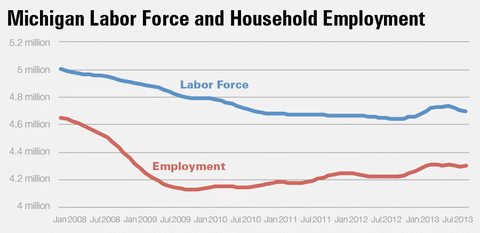Analysis: Michigan's Labor Force Growth Among Fastest in Nation
But unemployment remains high because more people looking for work
Now that it is election season, the direction of the state economy is put under more public scrutiny.
One of the common criticisms of Michigan's performance has been its stubbornly high unemployment rate, which remains above national averages and is 4th highest in the nation.
There were 45 straight months when Michigan had the highest unemployment rate in the country, so even the state's current ranking is an improvement.
The unemployment rate is calculated by dividing the number of people looking for work by the number of people in the labor force.
While generally improving economic health means it is easier to find a job, a decreasing labor force can improve the unemployment rate but be a sign of a weak economy. Michigan's labor force dropped by 109,000 people from 2000 to 2007, for instance.
A falling labor force could mean that people have given up looking for jobs or moved out of the state. Reductions in labor force aren't exclusively signs of weak economies, however. For example, an aging workforce will naturally decrease as more employees retire.
The 2008 recession rocked both the employment levels and the size of the state labor force. Employment dropped 530,000 and labor force dropped 284,620, sending the state unemployment rate to 14.2 percent (initially reported as 15.3 percent).
Note that the fall in labor force during the recession meant that the unemployment rate did not jump as much as it would have.
Since the recession ended, the state's labor force has stabilized. There even was an increase this year. While the survey found that this growth turned around toward the end of the year, this would be the first substantial increase since 2000.
Only 19 states increased their labor forces from December 2012 to December 2013, and Michigan increased the 5th most in adding people to the labor force. Michigan also grew 7th most in the increase in household employment. Substantial growth in the size of the labor force depresses the unemployment rate even when Michigan is a national leader in job growth.
The figures started turning in a different direction toward the end of the year. Labor force declined by 33,000 people while employment declined by 9,000 people from July to December. While both of these indicate a weakening economy, that weakness would not show up in the unemployment rate since the labor force fell more than employment.
A healthy economy will simultaneously employ more people and see more people interested in working. Michigan is experiencing both in this recovery, with monthly variations.
Michigan Capitol Confidential is the news source produced by the Mackinac Center for Public Policy. Michigan Capitol Confidential reports with a free-market news perspective.


 Michigan taxpayers foot $1 million bill for an imaginary job threat
Michigan taxpayers foot $1 million bill for an imaginary job threat
 Michigan clawing back $2.7B from 350,000 people
Michigan clawing back $2.7B from 350,000 people
 Michigan a top 10 state — for not creating jobs
Michigan a top 10 state — for not creating jobs
Jobs agency ghost-writes its own public relations